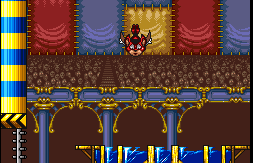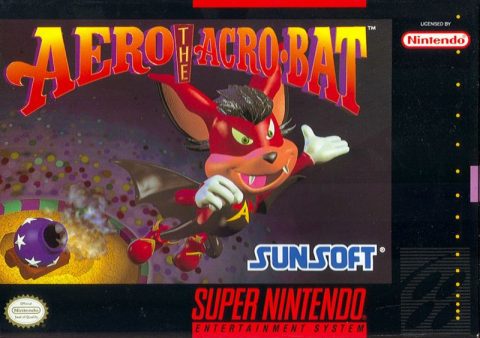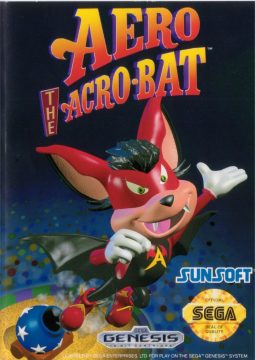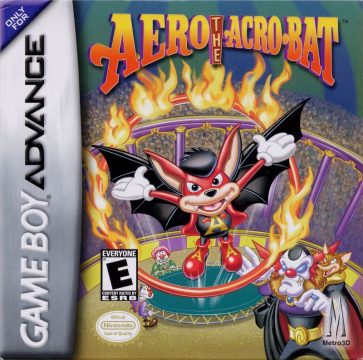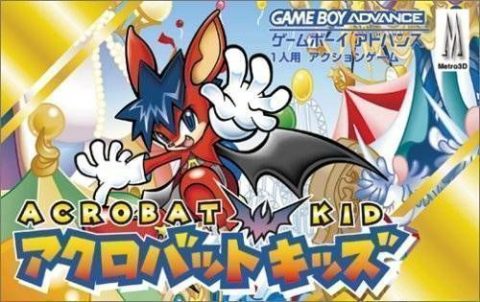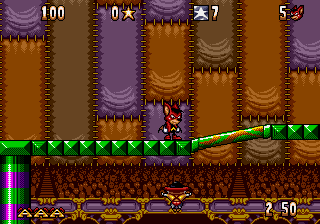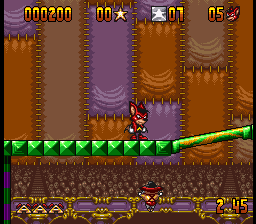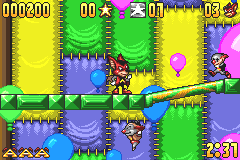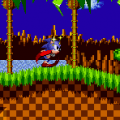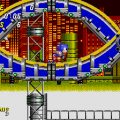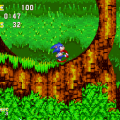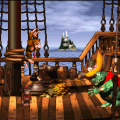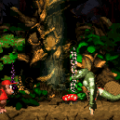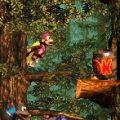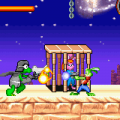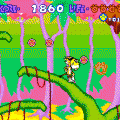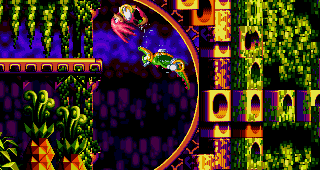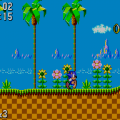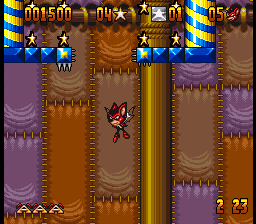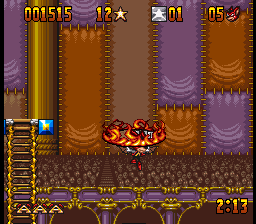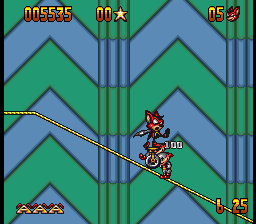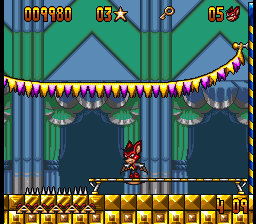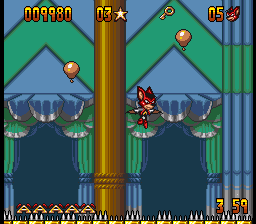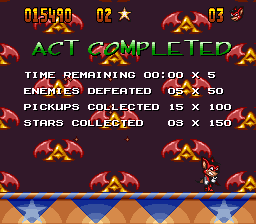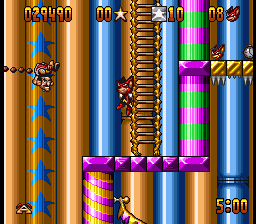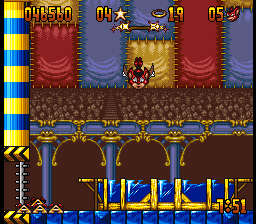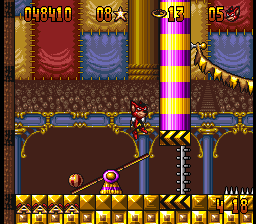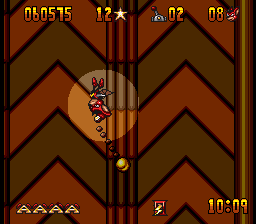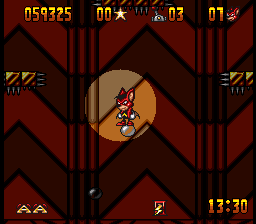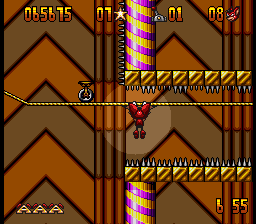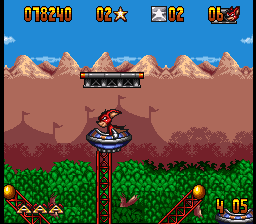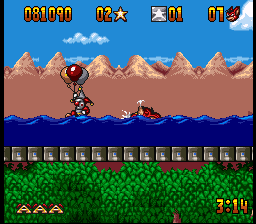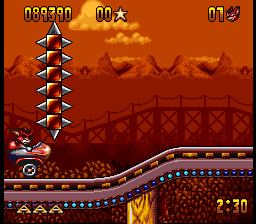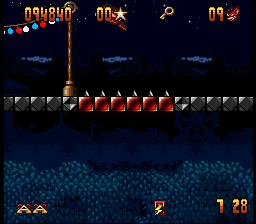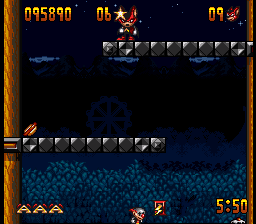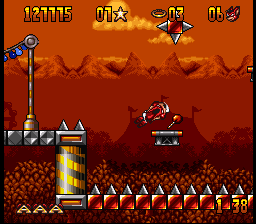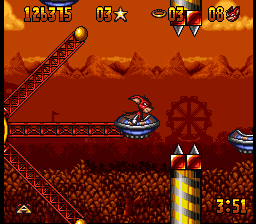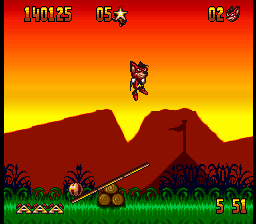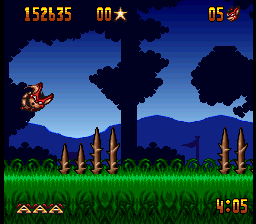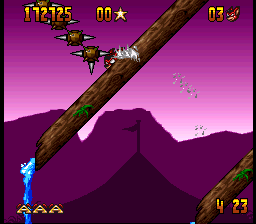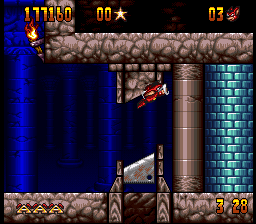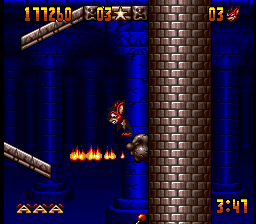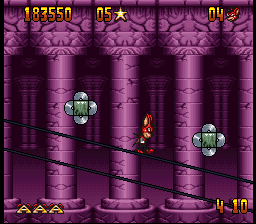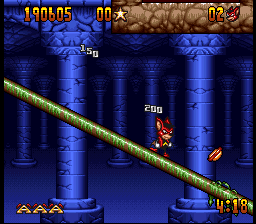- Aero the Acrobat
- Aero The Acrobat 2
- Zero the Kamikaze Squirrel
In the early to mid 90s, Sunsoft was in a strange place within the video gaming realm. Their Japanese branch had downplayed games somewhat in favor of adventures in real estate and golf courses, a decision that apparently didn’t bring much profit. Their American branch, however, stayed plenty busy as a publisher, bringing forth what was mostly a slew of Looney Tunes games from other developers. One particular exception was their attempt at a mascot that would compete against the then red-hot Sonic the Hedgehog in terms of attitude and marketability. Despite Sunsoft’s best efforts to push him, as seen in how many times he’d be hanging out on their logo, Aero was yet another casualty of the 16-bit mascot wars.
Which is somewhat of a shame, as while he’s not the most memorable character, nor are his games stunning technical achievements, they’re worthy games in their own right. While the first game in the series suffers from a punishing difficulty level, its sequel smooths that out for a game that’s much easier to get into. The final game in the series, a spinoff starring Aero’s rival in a time long before Shadow, is unique and intriguing enough to quite possibly be one of those “hidden gems”. Unfortunately, those three games were all there were. Unfortunately, Aero occupies a very sad place for a mascot – one not quite well-remembered to make a real comeback. At the very least, he doesn’t have to worry about being made into what Bubsy became.
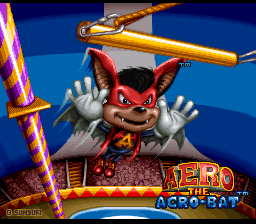
The evil Edgar Ektor has launched an attack on a local circus, a small army of circus performers joining him. Exactly what his motivations are isn’t very clear – the back of the box refers to him as a “madman industrialist”, which raises the question of why he’s dressed as a clown himself. The manual instead claims he’s a “bitter ex-clown”, which would do a lot more to answer that question. Either way, the only one capable of defeating Ektor is Aero, the circus’s star performer. It’s a simple plot without a single cutscene to complicate things, but for what it is, it serves well enough.
While Aero isn’t quite as fast as Sonic, he makes up for it with a fairly robust set of moves. The one you’ll be using most often is a head-first drilling attack you can perform in the air, aiming it diagonally upwards or downwards as needed. It serves as both a double jump and your primary form of offense, letting you take out enemies both airborne and on the ground. Care needs to be taken, however, as the downwards drill will carry Aero across the floor when he reaches the ground, potentially dragging him into one of the many, many hazards. More rarely, you’ll also collect magical stars that can be thrown, best saved for enemies too dangerous to get close to.
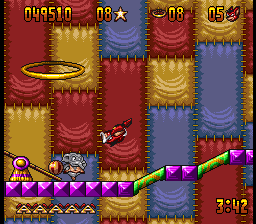
As befitting of a circus-themed performer, you’ll also find plenty of stunts to pull off scattered across the levels, each of which will help you get around or lead you into yet another trap. In the first world alone, you’ll find cannons that you’ll have to find the launch of to reach the best height, diving boards that lead to pools of water below, or unicycles that can mow down a line of enemies. Later worlds move away from the circus theme and thus lose this aspect somewhat, moving to what feels more typical for a platformer. While it lasts, however, it makes for something that feels distinctly unique.
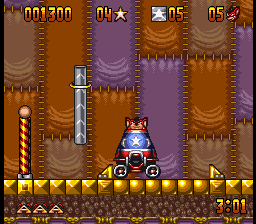
Each level presents you with a particular goal that has to be accomplished before the exit will open. You might be tasked to pass through a certain number of hoops, or leap on so many platforms to make them disappear. Sometimes it’s as easy as finding one particular item and bringing it to the end of the stage, or even simply making it to the end. The variety of objectives is somewhat of a tradeoff, often leaning towards the worse. While it helps the game stand out somewhat from its competition, the more exploration-heavy levels can soon prove to be frustrating.
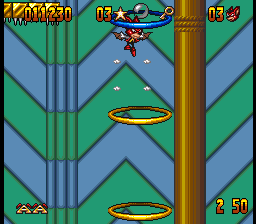
When you’re set to find a certain number of things, there’s no buffer – either you find everything or you’re not leaving the level. Generally, the things you need are on the critical path to the exit. Unfortunately, however, this isn’t always the case, and it’s entirely possible you might take the wrong fork through the level and miss something you needed. This is especially troublesome because the level design in Aero also happens to be utterly brutal.
The game has a nasty habit of placing spikes and other similar hazards in the worst possible places. You might find them between platforms you’ll have to jump between, hanging above trampolines you’ll have to carefully bounce across, at the bottom of a leap of faith you have to chance, or at the sides of platforms you’ll have to jump towards. Invariably, however, they’ll kill you dead the moment you touch them, regardless of how much health you have. Unlike its inspiration, in Aero, speed kills. Success means taking your time and using the look button frequently to see what’s around you.
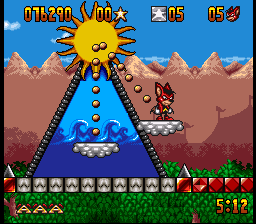
Placed almost as commonly as the spikes are various secret areas scattered throughout the level, usually placed just behind false walls. Each of these secrets usually contains an extra life, along with stars, health, and food for bonus points. You’ll want to look out for as many secret areas as you can, as you’ll quickly chew through all the lives the game is hiding as quickly as you earn them. Health is almost just as valuable – Aero can take up to five hits, but pick up more than that and they’re wasted, meaning you won’t have them later should you have to revisit the area you grabbed them from. At the very least, checkpoints are reasonably common, often placed just before and after particularly annoying sequences.
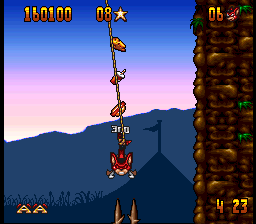
The game is at its most difficult when it launches into one of several vehicle-based obstacle courses scattered throughout the game. Aero will find himself in a rocket-powered vehicle on a rail, inside a barrel, or down a set of log flumes, each of which only gets tougher as the game progresses. In each case, you’ll need near instant timing to navigate the course, and should you touch even one obstruction, you’re dead. They make for frighteningly difficult sequences in an already tough game, ones that could very well overthrow the dead horse that is the Turbo Tunnel. They make for good variety from the slower, more exploration heavy platforming, but they’ll chew through those well earned lives in a minute flat.
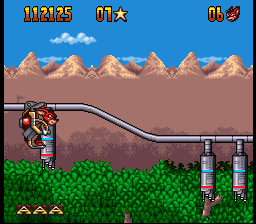
You’re already dead.
Not even the enemies are generally worth worrying about, even if they have their own share of annoyances. Most can be dispatched with one hit, but sometimes end up placed at angles that can be tough for your drill attack to hit. Others throw projectiles that can be hard to see, knocking you out of a jump and potentially towards the death waiting below. You’ll also find some foes that take multiple hits, often counterattacking as soon as your own attack lands. These enemies are often the worst as it’s unclear if you’ve actually dealt damage to them or not, making it so your best tactic is often avoiding them entirely.
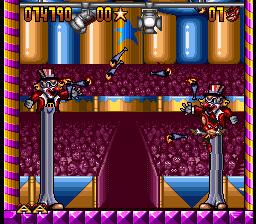
Should you run out lives, a very real possibility during any point in the game, you’re only offered three credits. Once you use one, you’re sent back to the very start of the world – and since each one offers four to five levels, that’s a very real amount of progress you’ve just lost, where you’ll have to navigate every treacherous obstacle all over again. Once your credits are up, there are no passwords to save you – you’ll have to keep in mind what took you out and try to find more lives next time around. One might ask if all the challenge the game offers is worth it. Despite everything it throws at you, however, the game never feels entirely unfair – you really have to start thinking the way the level designers did – if you think there’s spikes up ahead, there very likely are. Once you learn to take your time and dig around for secrets, the game just starts to make sense.
During the first few stages in the circus, the game makes somewhat of a rough impression. All but one of its five levels make you find a certain number of things, and the wide-open level design can make that difficult at times. What the game does well once you get past that initial hurdle, however, is offer a surprising amount of variety between the game’s worlds. The funfair offers more linear levels, mixed with the first few vehicle sections that’ll give you real trouble. The woods test your reactions through several levels, with only a little basic platforming. The final stages in Ektor’s museum, however, put you through a gauntlet of precision platforming with no surprises to get in the way.
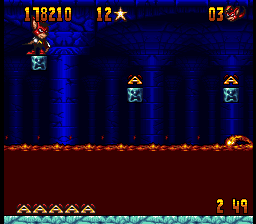
The game’s ending is somewhat brutal, but worth it after all the pain you’ve been through. After a harrowing vertical climb as you chase down and destroy Ektor’s flying machine, the villian ends up teetering from the edge of his tower. With one more drill attack, Aero knocks the clown off, nodding in quiet satisfaction. As the credits play out and Ektor hurtles towards the ground, the bat patiently listens out for the inevitable thud, then proceeds to start moonwalking. Ice cold.
The graphics, while somewhat basic by the standards of 1993, serve well enough. The sprites on the smaller side, which at least usually prevents you from running into things you can’t see too often. While he’s not the most exciting of characters, Aero has a few cute animations like his moonwalking between stages, or the way his eyes bug out when one of the bosses grabs him, that help to give him enough life. The stages, however, are somewhat on the bland side, although they’re at least colorful and distinctive enough on their own. The music is almost overpoweringly loud on either end, but once you get used to it, its bouncy, fairground organ-esque soundtrack fits well with the game’s general theme.
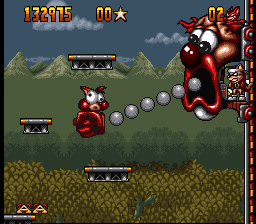
The Genesis version is mostly similar, although it has a few music tracks that are entirely different from its SNES counterpart. One of its bonus stages, where Aero leaps off a sky-high diving board towards a pool of water in Mode 7, also had to be cut. In its place is a 2D stage inside the circus where Aero bounces off one one of the diving boards previously seen in the game towards a pool below.
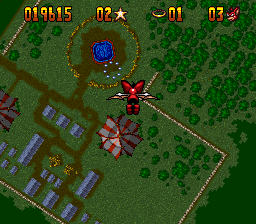
SNES
The Game Boy Advance version was released in 2003, long after most people had forgotten about the series entirely. It wasn’t especially popular, killing any chance for a comeback. This version makes several changes, including a rather poorly drawn comic intro that reveals that Ektor was banned from the circus for a dangerous prank he pulled as a child. This doesn’t, however, explain why he dresses like an evil clown.
The screen resolution is far smaller, and the pallete has been brightened up considerably to make up for the handheld’s darker screen. Aero’s sprite has also been replaced with the more animated one from Aero 2, although it’s missing quite a few frames of animation from the original sprite. The music tries it best to sound like the SNES version’s soundtrack, but comes off far poorer due to a lack of effects placed over it and generally being far too loud.
More substantially, just about everything has been changed to make the game far easier. Aero’s hover ability now gives you a second of flight, potentially saving you from bad jumps. Moreover, the level design has been changed to have far less spikes, and those that remain will no longer kill you on contact. Enemies that used to take multiple hits now only take one, and many drop health pickups. Star pickups are now worth five the original’s one, making foes even easier to take out. On top of that, the game now saves between levels, and if that isn’t enough, you have unlimited continues.
Despite the difficulty tweaks, navigating levels can be difficult with the GBA’s far smaller screen. The game feel isn’t quite right – Aero moves much more quickly and falls towards the ground much faster than before, which can make things feel off if you’re used to the console original. Upon finishing the game, a harder mode that’s much closer to the original game is unlocked — albeit with the much appreciated save feature.
This version was also released in Japan until the title Acrobat Kid, the first time any game in the series would appear in that country. While the cover art is much different, featuring a much more anime-styled art design, the actual game is almost entirely unchanged.
To be sure, the brutal platforming that this game throws at you isn’t going to be for everybody. If you like the game’s concept, but its difficulty level less so, there’s no shame in skipping to its sequel. Still, the original game has a certain charm and originality to it that Aero 2 lacks, which still makes it worthy. It’s a game that’s rather rough around the edges, to be sure, but if you want a game that tries to be more than just another Sonic killer, you might just appreciate it.
